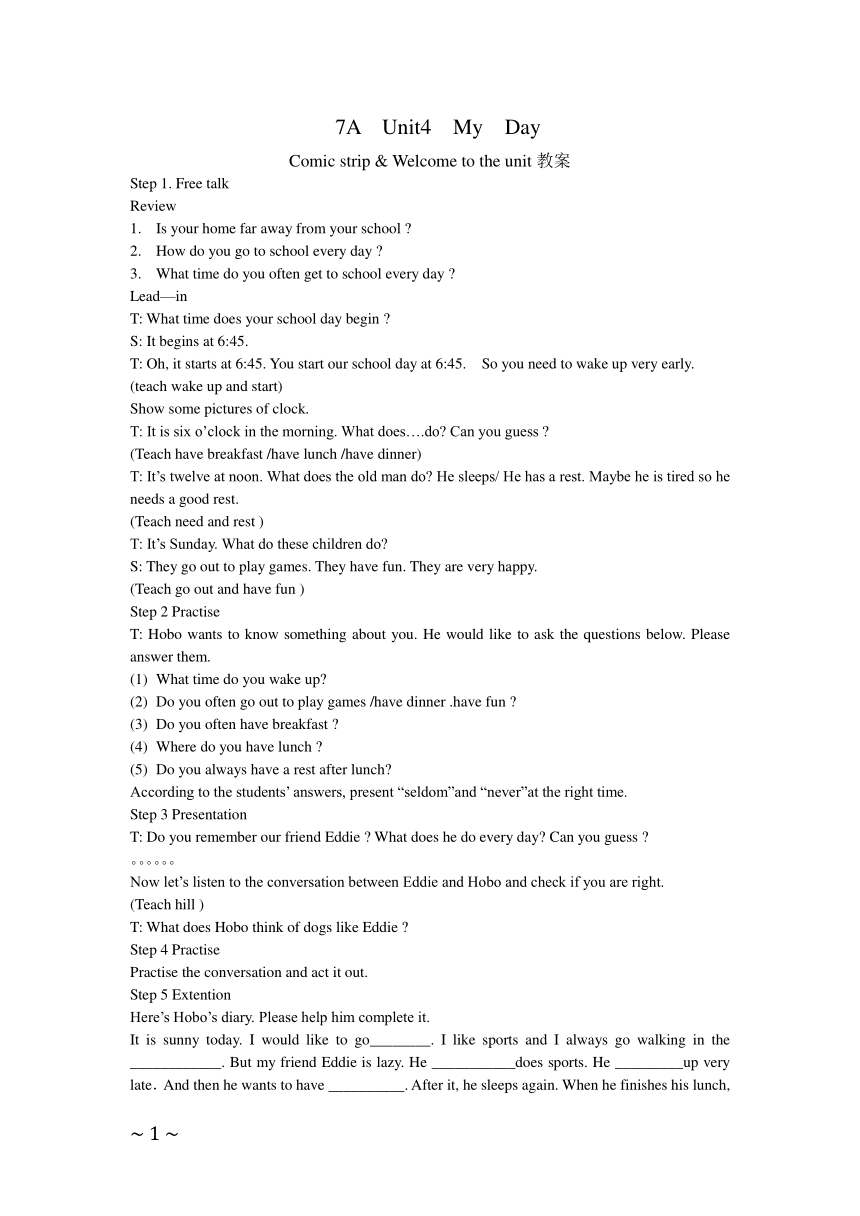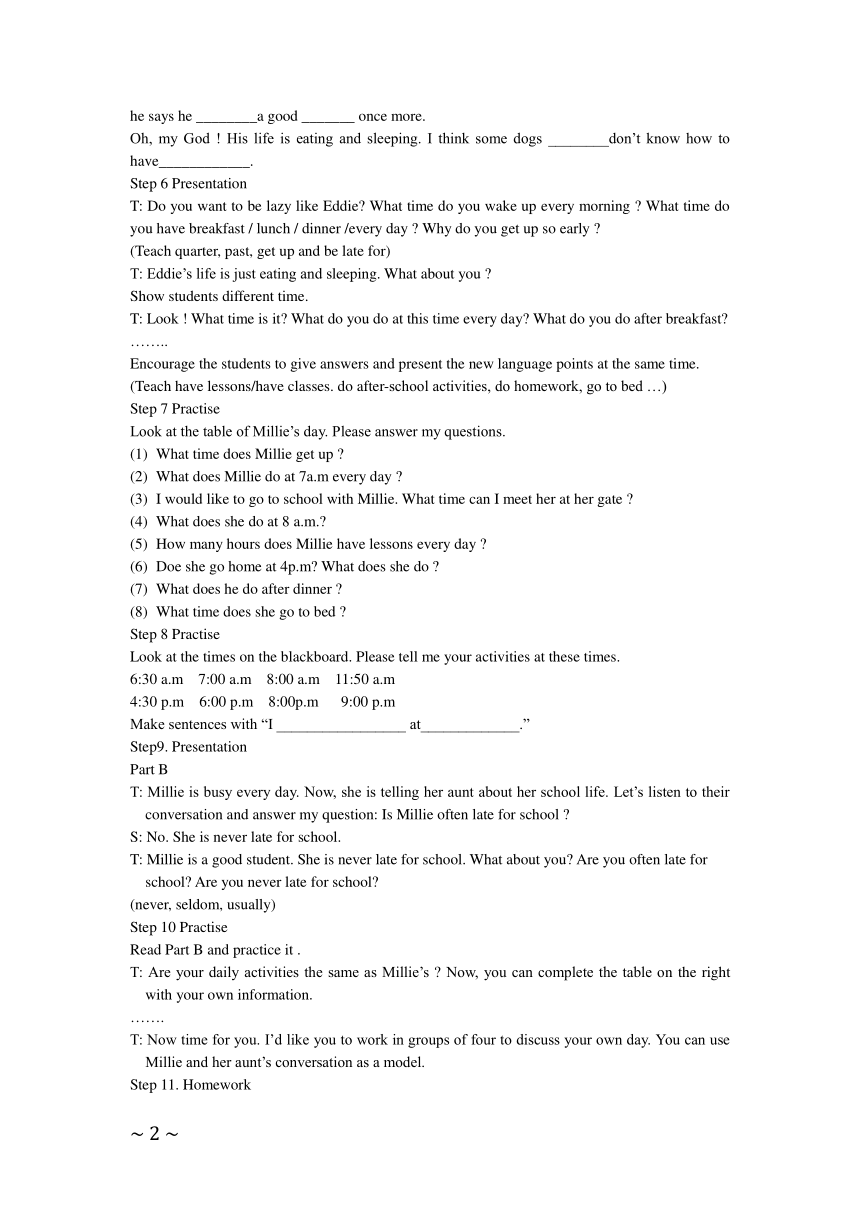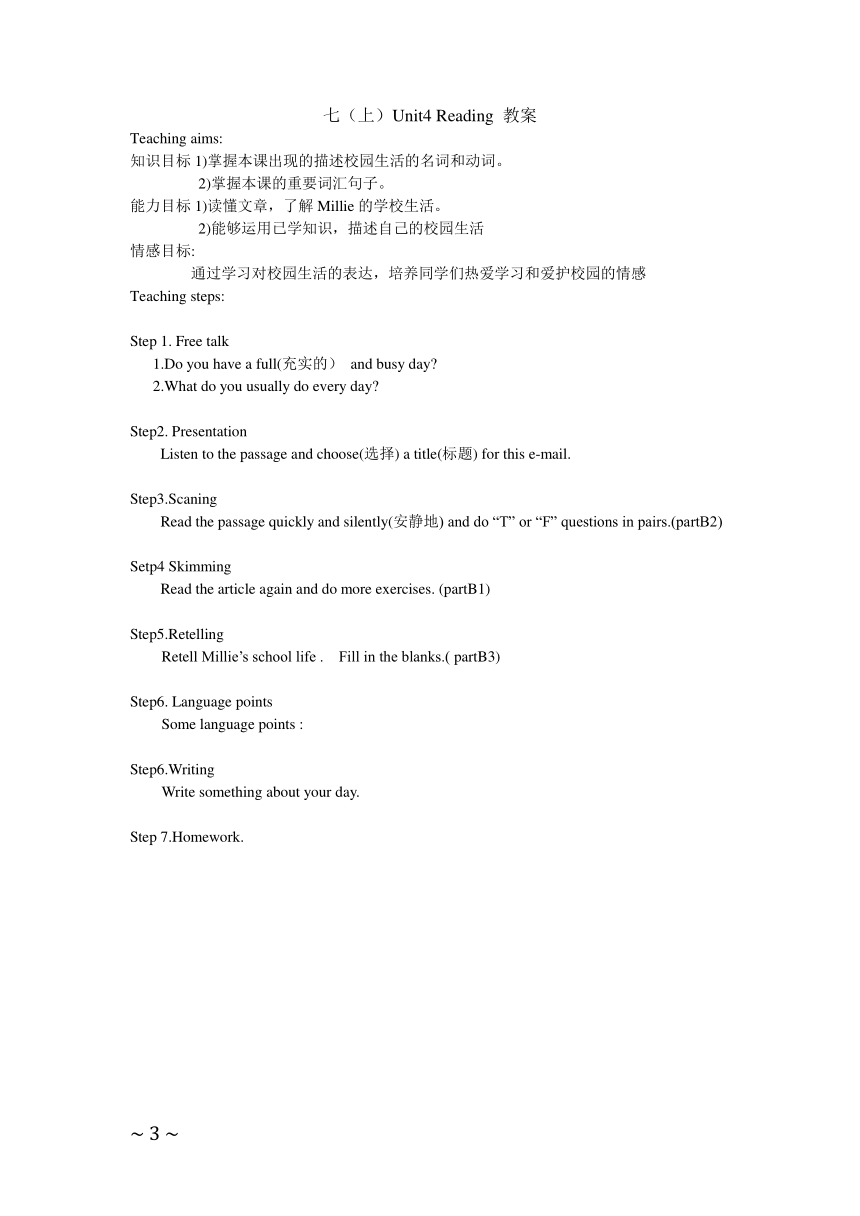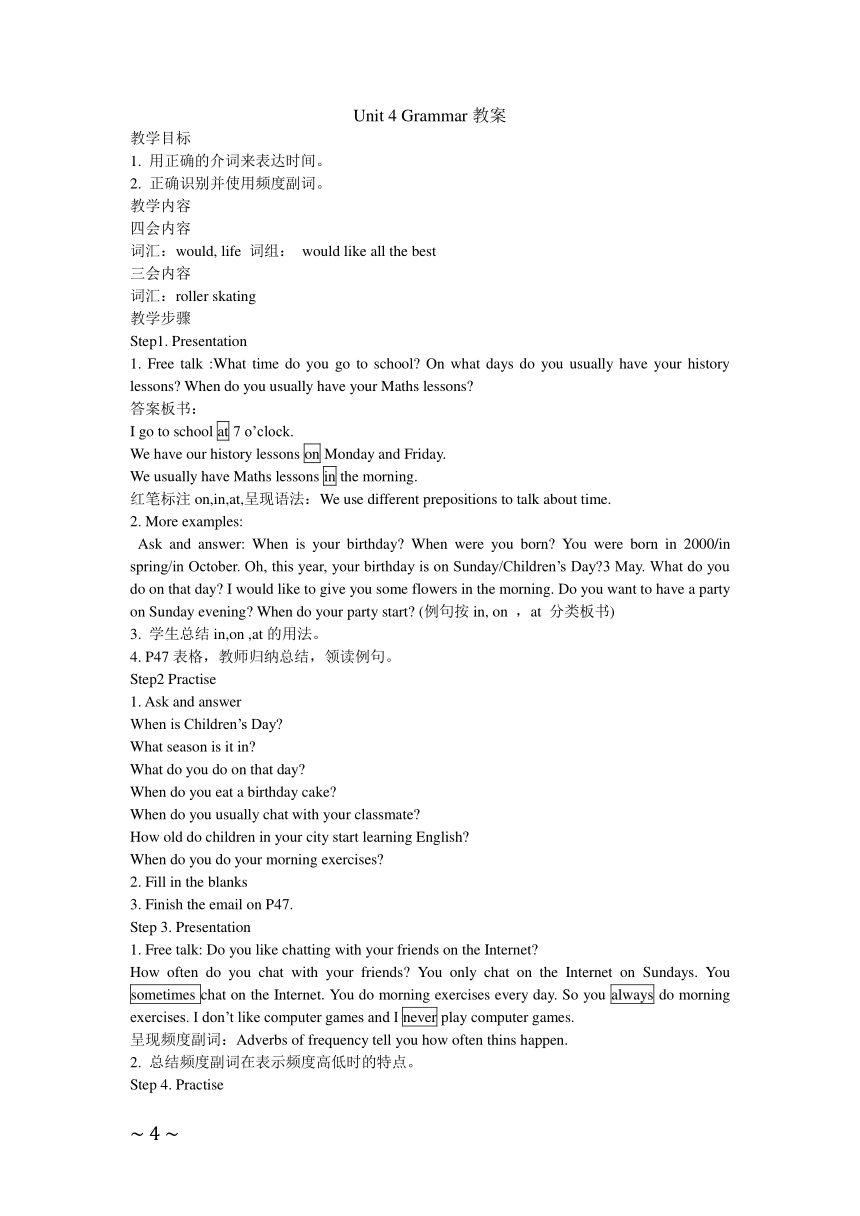7A Unit4 My day 教案(共6个课时)
文档属性
| 名称 | 7A Unit4 My day 教案(共6个课时) |  | |
| 格式 | zip | ||
| 文件大小 | 19.1KB | ||
| 资源类型 | 教案 | ||
| 版本资源 | 牛津译林版 | ||
| 科目 | 英语 | ||
| 更新时间 | 2012-11-28 19:34:01 | ||
图片预览





文档简介
7A Unit4 My Day
Comic strip & Welcome to the unit教案
Step 1. Free talk
Review
Is your home far away from your school ?
How do you go to school every day ?
What time do you often get to school every day ?
Lead—in
T: What time does your school day begin ?
S: It begins at 6:45.
T: Oh, it starts at 6:45. You start our school day at 6:45. So you need to wake up very early.
(teach wake up and start)
Show some pictures of clock.
T: It is six o’clock in the morning. What does….do? Can you guess ?
(Teach have breakfast /have lunch /have dinner)
T: It’s twelve at noon. What does the old man do? He sleeps/ He has a rest. Maybe he is tired so he needs a good rest.
(Teach need and rest )
T: It’s Sunday. What do these children do?
S: They go out to play games. They have fun. They are very happy.
(Teach go out and have fun )
Step 2 Practise
T: Hobo wants to know something about you. He would like to ask the questions below. Please answer them.
What time do you wake up?
Do you often go out to play games /have dinner .have fun ?
Do you often have breakfast ?
Where do you have lunch ?
Do you always have a rest after lunch?
According to the students’ answers, present “seldom”and “never”at the right time.
Step 3 Presentation
T: Do you remember our friend Eddie ? What does he do every day? Can you guess ?
。。。。。。
Now let’s listen to the conversation between Eddie and Hobo and check if you are right.
(Teach hill )
T: What does Hobo think of dogs like Eddie ?
Step 4 Practise
Practise the conversation and act it out.
Step 5 Extention
Here’s Hobo’s diary. Please help him complete it.
It is sunny today. I would like to go________. I like sports and I always go walking in the ____________. But my friend Eddie is lazy. He ___________does sports. He _________up very late.And then he wants to have __________. After it, he sleeps again. When he finishes his lunch, he says he ________a good _______ once more.
Oh, my God ! His life is eating and sleeping. I think some dogs ________don’t know how to have____________.
Step 6 Presentation
T: Do you want to be lazy like Eddie? What time do you wake up every morning ? What time do you have breakfast / lunch / dinner /every day ? Why do you get up so early ?
(Teach quarter, past, get up and be late for)
T: Eddie’s life is just eating and sleeping. What about you ?
Show students different time.
T: Look ! What time is it? What do you do at this time every day? What do you do after breakfast?
……..
Encourage the students to give answers and present the new language points at the same time.
(Teach have lessons/have classes. do after-school activities, do homework, go to bed …)
Step 7 Practise
Look at the table of Millie’s day. Please answer my questions.
What time does Millie get up ?
What does Millie do at 7a.m every day ?
I would like to go to school with Millie. What time can I meet her at her gate ?
What does she do at 8 a.m.?
How many hours does Millie have lessons every day ?
Doe she go home at 4p.m? What does she do ?
What does he do after dinner ?
What time does she go to bed ?
Step 8 Practise
Look at the times on the blackboard. Please tell me your activities at these times.
6:30 a.m 7:00 a.m 8:00 a.m 11:50 a.m
4:30 p.m 6:00 p.m 8:00p.m 9:00 p.m
Make sentences with “I _________________ at_____________.”
Step9. Presentation
Part B
T: Millie is busy every day. Now, she is telling her aunt about her school life. Let’s listen to their conversation and answer my question: Is Millie often late for school ?
S: No. She is never late for school.
T: Millie is a good student. She is never late for school. What about you? Are you often late for
school? Are you never late for school?
(never, seldom, usually)
Step 10 Practise
Read Part B and practice it .
T: Are your daily activities the same as Millie’s ? Now, you can complete the table on the right with your own information.
…….
T: Now time for you. I’d like you to work in groups of four to discuss your own day. You can use Millie and her aunt’s conversation as a model.
Step 11. Homework
七(上)Unit4 Reading 教案
Teaching aims:
知识目标1)掌握本课出现的描述校园生活的名词和动词。
2)掌握本课的重要词汇句子。
能力目标1)读懂文章,了解Millie的学校生活。
2)能够运用已学知识,描述自己的校园生活
情感目标:
通过学习对校园生活的表达,培养同学们热爱学习和爱护校园的情感
Teaching steps:
Step 1. Free talk
1.Do you have a full(充实的) and busy day?
2.What do you usually do every day?
Step2. Presentation
Listen to the passage and choose(选择) a title(标题) for this e-mail.
Step3.Scaning
Read the passage quickly and silently(安静地) and do “T” or “F” questions in pairs.(partB2)
Setp4 Skimming
Read the article again and do more exercises. (partB1)
Step5.Retelling
Retell Millie’s school life . Fill in the blanks.( partB3)
Step6. Language points
Some language points :
Step6.Writing
Write something about your day.
Step 7.Homework.
Unit 4 Grammar教案
教学目标
1. 用正确的介词来表达时间。
2. 正确识别并使用频度副词。
教学内容
四会内容
词汇:would, life 词组: would like all the best
三会内容
词汇:roller skating
教学步骤
Step1. Presentation
1. Free talk :What time do you go to school? On what days do you usually have your history lessons? When do you usually have your Maths lessons?
答案板书:
I go to school at 7 o’clock.
We have our history lessons on Monday and Friday.
We usually have Maths lessons in the morning.
红笔标注on,in,at,呈现语法:We use different prepositions to talk about time.
2. More examples:
Ask and answer: When is your birthday? When were you born? You were born in 2000/in spring/in October. Oh, this year, your birthday is on Sunday/Children’s Day?3 May. What do you do on that day? I would like to give you some flowers in the morning. Do you want to have a party on Sunday evening? When do your party start? (例句按in, on ,at 分类板书)
3. 学生总结in,on ,at的用法。
4. P47表格,教师归纳总结,领读例句。
Step2 Practise
1. Ask and answer
When is Children’s Day?
What season is it in?
What do you do on that day?
When do you eat a birthday cake?
When do you usually chat with your classmate?
How old do children in your city start learning English?
When do you do your morning exercises?
2. Fill in the blanks
3. Finish the email on P47.
Step 3. Presentation
1. Free talk: Do you like chatting with your friends on the Internet?
How often do you chat with your friends? You only chat on the Internet on Sundays. You sometimes chat on the Internet. You do morning exercises every day. So you always do morning exercises. I don’t like computer games and I never play computer games.
呈现频度副词:Adverbs of frequency tell you how often thins happen.
2. 总结频度副词在表示频度高低时的特点。
Step 4. Practise
1. Talk about the pictures
2. Finish the exercise on P 48.
3. Ask and answer
Step 5. Production
Make an interview(采访)
Make a dialogue to talk about your school life or your own day in pairs. Suppose one of you is an interviewer of your school video station教师先呈现示范。然后学生操练并表演。
Homework:
1. Make a dialogue to talk about time.
2. Make a dialogue to talk about your diet (饮食)and lifestyle(生活方式).
3. Finish the exercises in the workbook.
?
7A Unit4 Integrated Skills
教学目标:
根据听力材料识别信息并进行选择;
有目的的听取材料并摘取相关信息;
用所得信息将语篇补充完整;
就校内活动与他人进行交流。
教学内容
四会内容
词汇:wish luck museum twice picnic once
词组:visit the museum twice a month
go on a picnics once a week
句型:That’s great!
Wish our team good luck!
教学步骤:
Step one: Free talk
When do you go to school every day?
What do you often do at school?
Do you enjoy school? What do you often do at school?
Step two: Presentation
Here are some photos of sports activities in our school. What kind of activity is this?
Which activity do you like best?
How often do you practise it? You practise it once a week. (呈现新单词once)
Why do you like this kind of activity? You practise it every day. I wish you the best.
(呈现wish)
Do you have a volleyball/basketball match in your school? Does your team often win? I wish your team good luck! (板书luck和good luck)
Step three Listening
Mille is talking with Simon about a volleyball match. Listen to their conversation. Tick the correct answer to each question.
Step four: Complete the notes.
Simon is making notes about the volleyball match. Let’s listen to the conversation again and help him complete the notes in Part A2.
Simon wants to write a notice about the volleyball match to his classmates. Would you please help him complete it?
Step Five: Speak up
1) Mille is chatting online with Tommy about their weekends. Let’s listen to their conversation and answer some questions.
Q1: What does Millie like to do at weekends?
She likes to visit the museum.
Q2:What does Tommy like to do at weekends?
He likes to go on picnics with family.
Q3: How often does Millie visit the museum?
She visits the museum about twice a month.
Q4:How often does Tommy go on a picnic?
He goes on a picnic about once a week. 2)read the conversations and act it.
3)languages points
(1) Wish our team good luck!
wish v. 希望,祝愿
eg:I wish you a happy birthday.(wish sb sth)
n. 希望,祝愿
eg. Best wishes!
luck n 运气 lucky adj 运气好的
eg: Good luck!
a lucky dog 幸运儿
(2)once adv 一次 twice adv
once a week
4) What do you like to do at weekends? Work in pairs and talk about your weekends.
You can use these useful expressions:
What do you like to do at weekends?
I like …….
How often ……?
Step Six: Homework
教学反思
7A Unit4 My day Study Skills教案
Content: Study Skills
Teaching aims:
1.学习常见的元音字母组合的发音。
2.对比类似的元音字母组合发音的异同。
3.运用本课所学读音规律,准确朗读新单词
4.正确且流利地朗读含有本课所学读音规律的短语
Important points:
1.元音字母组合的发音[ɑ:] [?:] [i:] [e] [u:][?] [?:] [?]
2.准确朗读新单词
Teaching approaches: Practice
Teaching aids: A tape recorder CD
Teaching procedures:
Step 1:
向学生呈现两段绕口令,引入本课时教学内容
T: Do you like tongue twisters? I have two here, would you like to have a try to read them?
Mr. Cook says to a cook, “Look at the book. It’s very good.”
Dr Keep says to a keeper, “Look after the tiger. It’s very clever.”
领读绕口令,指导学生朗读,并且用彩色笔将发音为[i:] [u:][?] [?:] [?]的元音字母组合标注出来
[i:]:keep keeper
[u]:cook look book good
[?]:a tiger clever after keeper
3.通过小诗,呈现元音字母组合及发音[ɑ:] [?:] [e]
Good weather,bright star。
Father Horn is in his car
Shakes head,plays the guitar
With Dog Ball goes far
Step2:
将课本51页表格右边的音标遮挡起来,学生自己总结单词的发音
listen to the tape and read after the tape
(注意:相同的元音字母组合可能有不同的发音,比如:oo组合的两种发音[u:][?],ea的两种发音[i:] [e],or组合的三种发音[?:] [?:] [?])
判断各组单词中黑体部分字母组合的发音是否相同:
sport work(×)
pardon member(×)
foot good(√)
thirty girl (√)
tea sweater(×)
T: Look at the big tree in Part A. Try to put the words on the left on the leaves according to their sounds.
Step3
T: Look at the picture. There is a bird on the tree. Can you read the new word according to the words you have learned?
The eagle like eating meat
Step4
1.完成课本B部分练习
T: Look at the following pairs of words. Read the words on the left first, and then try to say the words on the right correctly.
朗读C部分的短语
T:Let’s practice saying te following phrases in Part C
Ask some students to say these words loudly.
Step5
利用一个chant,帮助学生训练发音
The coolest thing that I have seen by far
Is when I took photo with the pop star
He jumped on to the hood of his car
And looked smart with his guitar
I have got the beat
From my head to my feet
I started to scream
I started to dream
Of a wonderful world
That I have ever heard
Step6 homework
朗读课本上提供的语音练习。
完成教师布置的口头练习和书面练习。
预习Task。
7A Unit4 My day Task教案
Teaching aims:
1.表达对学校活动的喜爱程度。
2.说明喜欢或不喜欢某种活动的原因。
3运用本单元所学知识写一篇文章,介绍自己对学校活动的喜欢程度。
Teaching Procedures:
Step One. Greetings & Free talk
??????Greet each other & Ask the Ss to have some free talks with:
1. “Can I / you …?” and “ May I / you …?”
2. … like / likes …????????… don’t / doesn’t like …????
And then introduce the word “dislike”
Step Two. Presentation
Ask the Ss to make some sentences about their likes or dislikes.
Let some Ss draw faces on the Bb to express their feelings, such as, love, like and dislike
Ask the Ss to say something they like or dislike and say WHY
Step Three. Complete “My happiness chart” in Part B
??????Just ask the Ss to draw faces like the ones in Part A according to their likes and dislikes
Step Four. Look at Part A on P31
???????? First look at Millie’s chart, and then read about Millie’s likes and dislikes in the table below.
Pay more attention to Millie’s REASON
Language points:
1. happiness (n)??????happy (adj)?????? happily (adv)??
2. like???? like sb / sth / doing sth / to do sth
like sb to do sth
3. dislike?? like (opposite ) --- dislike?? dislike sb / sth / doing sth
4. learn????learn sth?????????????? learn to do sth
learn about sth??????????learn … about …
learn from sb?????????? learn … from sb
?learn more / much / a lot about … from …
?5. It’s fun to do sth.??????
It’s adj to do sth. = To do sth is adj.
(to do sth是真正的主语,而it是形式主语)
Step Five. Complete the table in Part B
1. Ask the Ss to complete the table in Part B, using the information from the happiness chart in Part A on P31. Tell them to use Millie’s sentences if necessary.
2. Ask the Ss to work in pairs to discuss the reasons why they like or dislike certain activities.
3. Check the answers of some students and correct the mistakes
Step Six. Homework??
???? 1. Ask the Ss to send their likes and dislikes to their e-friends on the Internet if possible
2. Preview the Workbook.
Comic strip & Welcome to the unit教案
Step 1. Free talk
Review
Is your home far away from your school ?
How do you go to school every day ?
What time do you often get to school every day ?
Lead—in
T: What time does your school day begin ?
S: It begins at 6:45.
T: Oh, it starts at 6:45. You start our school day at 6:45. So you need to wake up very early.
(teach wake up and start)
Show some pictures of clock.
T: It is six o’clock in the morning. What does….do? Can you guess ?
(Teach have breakfast /have lunch /have dinner)
T: It’s twelve at noon. What does the old man do? He sleeps/ He has a rest. Maybe he is tired so he needs a good rest.
(Teach need and rest )
T: It’s Sunday. What do these children do?
S: They go out to play games. They have fun. They are very happy.
(Teach go out and have fun )
Step 2 Practise
T: Hobo wants to know something about you. He would like to ask the questions below. Please answer them.
What time do you wake up?
Do you often go out to play games /have dinner .have fun ?
Do you often have breakfast ?
Where do you have lunch ?
Do you always have a rest after lunch?
According to the students’ answers, present “seldom”and “never”at the right time.
Step 3 Presentation
T: Do you remember our friend Eddie ? What does he do every day? Can you guess ?
。。。。。。
Now let’s listen to the conversation between Eddie and Hobo and check if you are right.
(Teach hill )
T: What does Hobo think of dogs like Eddie ?
Step 4 Practise
Practise the conversation and act it out.
Step 5 Extention
Here’s Hobo’s diary. Please help him complete it.
It is sunny today. I would like to go________. I like sports and I always go walking in the ____________. But my friend Eddie is lazy. He ___________does sports. He _________up very late.And then he wants to have __________. After it, he sleeps again. When he finishes his lunch, he says he ________a good _______ once more.
Oh, my God ! His life is eating and sleeping. I think some dogs ________don’t know how to have____________.
Step 6 Presentation
T: Do you want to be lazy like Eddie? What time do you wake up every morning ? What time do you have breakfast / lunch / dinner /every day ? Why do you get up so early ?
(Teach quarter, past, get up and be late for)
T: Eddie’s life is just eating and sleeping. What about you ?
Show students different time.
T: Look ! What time is it? What do you do at this time every day? What do you do after breakfast?
……..
Encourage the students to give answers and present the new language points at the same time.
(Teach have lessons/have classes. do after-school activities, do homework, go to bed …)
Step 7 Practise
Look at the table of Millie’s day. Please answer my questions.
What time does Millie get up ?
What does Millie do at 7a.m every day ?
I would like to go to school with Millie. What time can I meet her at her gate ?
What does she do at 8 a.m.?
How many hours does Millie have lessons every day ?
Doe she go home at 4p.m? What does she do ?
What does he do after dinner ?
What time does she go to bed ?
Step 8 Practise
Look at the times on the blackboard. Please tell me your activities at these times.
6:30 a.m 7:00 a.m 8:00 a.m 11:50 a.m
4:30 p.m 6:00 p.m 8:00p.m 9:00 p.m
Make sentences with “I _________________ at_____________.”
Step9. Presentation
Part B
T: Millie is busy every day. Now, she is telling her aunt about her school life. Let’s listen to their conversation and answer my question: Is Millie often late for school ?
S: No. She is never late for school.
T: Millie is a good student. She is never late for school. What about you? Are you often late for
school? Are you never late for school?
(never, seldom, usually)
Step 10 Practise
Read Part B and practice it .
T: Are your daily activities the same as Millie’s ? Now, you can complete the table on the right with your own information.
…….
T: Now time for you. I’d like you to work in groups of four to discuss your own day. You can use Millie and her aunt’s conversation as a model.
Step 11. Homework
七(上)Unit4 Reading 教案
Teaching aims:
知识目标1)掌握本课出现的描述校园生活的名词和动词。
2)掌握本课的重要词汇句子。
能力目标1)读懂文章,了解Millie的学校生活。
2)能够运用已学知识,描述自己的校园生活
情感目标:
通过学习对校园生活的表达,培养同学们热爱学习和爱护校园的情感
Teaching steps:
Step 1. Free talk
1.Do you have a full(充实的) and busy day?
2.What do you usually do every day?
Step2. Presentation
Listen to the passage and choose(选择) a title(标题) for this e-mail.
Step3.Scaning
Read the passage quickly and silently(安静地) and do “T” or “F” questions in pairs.(partB2)
Setp4 Skimming
Read the article again and do more exercises. (partB1)
Step5.Retelling
Retell Millie’s school life . Fill in the blanks.( partB3)
Step6. Language points
Some language points :
Step6.Writing
Write something about your day.
Step 7.Homework.
Unit 4 Grammar教案
教学目标
1. 用正确的介词来表达时间。
2. 正确识别并使用频度副词。
教学内容
四会内容
词汇:would, life 词组: would like all the best
三会内容
词汇:roller skating
教学步骤
Step1. Presentation
1. Free talk :What time do you go to school? On what days do you usually have your history lessons? When do you usually have your Maths lessons?
答案板书:
I go to school at 7 o’clock.
We have our history lessons on Monday and Friday.
We usually have Maths lessons in the morning.
红笔标注on,in,at,呈现语法:We use different prepositions to talk about time.
2. More examples:
Ask and answer: When is your birthday? When were you born? You were born in 2000/in spring/in October. Oh, this year, your birthday is on Sunday/Children’s Day?3 May. What do you do on that day? I would like to give you some flowers in the morning. Do you want to have a party on Sunday evening? When do your party start? (例句按in, on ,at 分类板书)
3. 学生总结in,on ,at的用法。
4. P47表格,教师归纳总结,领读例句。
Step2 Practise
1. Ask and answer
When is Children’s Day?
What season is it in?
What do you do on that day?
When do you eat a birthday cake?
When do you usually chat with your classmate?
How old do children in your city start learning English?
When do you do your morning exercises?
2. Fill in the blanks
3. Finish the email on P47.
Step 3. Presentation
1. Free talk: Do you like chatting with your friends on the Internet?
How often do you chat with your friends? You only chat on the Internet on Sundays. You sometimes chat on the Internet. You do morning exercises every day. So you always do morning exercises. I don’t like computer games and I never play computer games.
呈现频度副词:Adverbs of frequency tell you how often thins happen.
2. 总结频度副词在表示频度高低时的特点。
Step 4. Practise
1. Talk about the pictures
2. Finish the exercise on P 48.
3. Ask and answer
Step 5. Production
Make an interview(采访)
Make a dialogue to talk about your school life or your own day in pairs. Suppose one of you is an interviewer of your school video station教师先呈现示范。然后学生操练并表演。
Homework:
1. Make a dialogue to talk about time.
2. Make a dialogue to talk about your diet (饮食)and lifestyle(生活方式).
3. Finish the exercises in the workbook.
?
7A Unit4 Integrated Skills
教学目标:
根据听力材料识别信息并进行选择;
有目的的听取材料并摘取相关信息;
用所得信息将语篇补充完整;
就校内活动与他人进行交流。
教学内容
四会内容
词汇:wish luck museum twice picnic once
词组:visit the museum twice a month
go on a picnics once a week
句型:That’s great!
Wish our team good luck!
教学步骤:
Step one: Free talk
When do you go to school every day?
What do you often do at school?
Do you enjoy school? What do you often do at school?
Step two: Presentation
Here are some photos of sports activities in our school. What kind of activity is this?
Which activity do you like best?
How often do you practise it? You practise it once a week. (呈现新单词once)
Why do you like this kind of activity? You practise it every day. I wish you the best.
(呈现wish)
Do you have a volleyball/basketball match in your school? Does your team often win? I wish your team good luck! (板书luck和good luck)
Step three Listening
Mille is talking with Simon about a volleyball match. Listen to their conversation. Tick the correct answer to each question.
Step four: Complete the notes.
Simon is making notes about the volleyball match. Let’s listen to the conversation again and help him complete the notes in Part A2.
Simon wants to write a notice about the volleyball match to his classmates. Would you please help him complete it?
Step Five: Speak up
1) Mille is chatting online with Tommy about their weekends. Let’s listen to their conversation and answer some questions.
Q1: What does Millie like to do at weekends?
She likes to visit the museum.
Q2:What does Tommy like to do at weekends?
He likes to go on picnics with family.
Q3: How often does Millie visit the museum?
She visits the museum about twice a month.
Q4:How often does Tommy go on a picnic?
He goes on a picnic about once a week. 2)read the conversations and act it.
3)languages points
(1) Wish our team good luck!
wish v. 希望,祝愿
eg:I wish you a happy birthday.(wish sb sth)
n. 希望,祝愿
eg. Best wishes!
luck n 运气 lucky adj 运气好的
eg: Good luck!
a lucky dog 幸运儿
(2)once adv 一次 twice adv
once a week
4) What do you like to do at weekends? Work in pairs and talk about your weekends.
You can use these useful expressions:
What do you like to do at weekends?
I like …….
How often ……?
Step Six: Homework
教学反思
7A Unit4 My day Study Skills教案
Content: Study Skills
Teaching aims:
1.学习常见的元音字母组合的发音。
2.对比类似的元音字母组合发音的异同。
3.运用本课所学读音规律,准确朗读新单词
4.正确且流利地朗读含有本课所学读音规律的短语
Important points:
1.元音字母组合的发音[ɑ:] [?:] [i:] [e] [u:][?] [?:] [?]
2.准确朗读新单词
Teaching approaches: Practice
Teaching aids: A tape recorder CD
Teaching procedures:
Step 1:
向学生呈现两段绕口令,引入本课时教学内容
T: Do you like tongue twisters? I have two here, would you like to have a try to read them?
Mr. Cook says to a cook, “Look at the book. It’s very good.”
Dr Keep says to a keeper, “Look after the tiger. It’s very clever.”
领读绕口令,指导学生朗读,并且用彩色笔将发音为[i:] [u:][?] [?:] [?]的元音字母组合标注出来
[i:]:keep keeper
[u]:cook look book good
[?]:a tiger clever after keeper
3.通过小诗,呈现元音字母组合及发音[ɑ:] [?:] [e]
Good weather,bright star。
Father Horn is in his car
Shakes head,plays the guitar
With Dog Ball goes far
Step2:
将课本51页表格右边的音标遮挡起来,学生自己总结单词的发音
listen to the tape and read after the tape
(注意:相同的元音字母组合可能有不同的发音,比如:oo组合的两种发音[u:][?],ea的两种发音[i:] [e],or组合的三种发音[?:] [?:] [?])
判断各组单词中黑体部分字母组合的发音是否相同:
sport work(×)
pardon member(×)
foot good(√)
thirty girl (√)
tea sweater(×)
T: Look at the big tree in Part A. Try to put the words on the left on the leaves according to their sounds.
Step3
T: Look at the picture. There is a bird on the tree. Can you read the new word according to the words you have learned?
The eagle like eating meat
Step4
1.完成课本B部分练习
T: Look at the following pairs of words. Read the words on the left first, and then try to say the words on the right correctly.
朗读C部分的短语
T:Let’s practice saying te following phrases in Part C
Ask some students to say these words loudly.
Step5
利用一个chant,帮助学生训练发音
The coolest thing that I have seen by far
Is when I took photo with the pop star
He jumped on to the hood of his car
And looked smart with his guitar
I have got the beat
From my head to my feet
I started to scream
I started to dream
Of a wonderful world
That I have ever heard
Step6 homework
朗读课本上提供的语音练习。
完成教师布置的口头练习和书面练习。
预习Task。
7A Unit4 My day Task教案
Teaching aims:
1.表达对学校活动的喜爱程度。
2.说明喜欢或不喜欢某种活动的原因。
3运用本单元所学知识写一篇文章,介绍自己对学校活动的喜欢程度。
Teaching Procedures:
Step One. Greetings & Free talk
??????Greet each other & Ask the Ss to have some free talks with:
1. “Can I / you …?” and “ May I / you …?”
2. … like / likes …????????… don’t / doesn’t like …????
And then introduce the word “dislike”
Step Two. Presentation
Ask the Ss to make some sentences about their likes or dislikes.
Let some Ss draw faces on the Bb to express their feelings, such as, love, like and dislike
Ask the Ss to say something they like or dislike and say WHY
Step Three. Complete “My happiness chart” in Part B
??????Just ask the Ss to draw faces like the ones in Part A according to their likes and dislikes
Step Four. Look at Part A on P31
???????? First look at Millie’s chart, and then read about Millie’s likes and dislikes in the table below.
Pay more attention to Millie’s REASON
Language points:
1. happiness (n)??????happy (adj)?????? happily (adv)??
2. like???? like sb / sth / doing sth / to do sth
like sb to do sth
3. dislike?? like (opposite ) --- dislike?? dislike sb / sth / doing sth
4. learn????learn sth?????????????? learn to do sth
learn about sth??????????learn … about …
learn from sb?????????? learn … from sb
?learn more / much / a lot about … from …
?5. It’s fun to do sth.??????
It’s adj to do sth. = To do sth is adj.
(to do sth是真正的主语,而it是形式主语)
Step Five. Complete the table in Part B
1. Ask the Ss to complete the table in Part B, using the information from the happiness chart in Part A on P31. Tell them to use Millie’s sentences if necessary.
2. Ask the Ss to work in pairs to discuss the reasons why they like or dislike certain activities.
3. Check the answers of some students and correct the mistakes
Step Six. Homework??
???? 1. Ask the Ss to send their likes and dislikes to their e-friends on the Internet if possible
2. Preview the Workbook.
同课章节目录
- 预备课程
- Lesson 1 Nice to meet you !
- Lesson 2 A happy family
- Lesson 3 A nice school
- Lesson 4 You look cool !
- Lesson 5 Wonderful things
- Lesson 6 Have nice food
- Lesson 7 Enjoy our days
- Lesson 8 Let's have fun !
- Unit 1 This is me
- Unit 2 Let's play sports
- Unit 3 Welcome to our school
- Unit 4 My day
- Unit 5 Let’s celebrate
- Unit 6 Food and lifestyle
- Unit 7 Shopping
- Unit 8 Fashion
